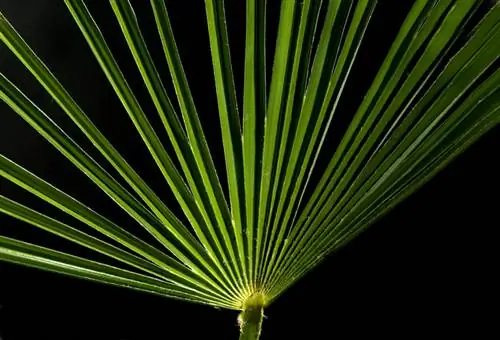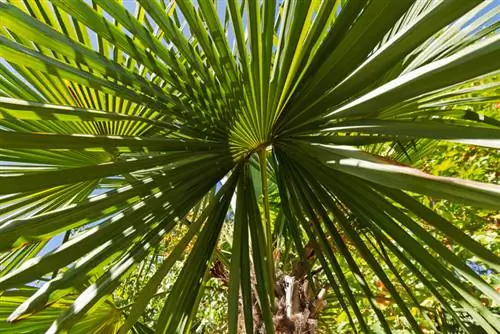- Author admin [email protected].
- Public 2023-12-16 16:46.
- Last modified 2025-01-23 11:20.
Whether in a pot or standing freely in the garden - the Chinese hemp palm is an extremely popular plant that creates a tropical and holiday-like flair in both summer and winter. It is considered to be frost-hardy and sun-loving. But what care does it need?

How do I properly care for a Chinese hemp palm?
The Chinese hemp palm requires regular watering with low-lime water, fertilization every 2-3 weeks during the growth phase and occasional repotting. To ensure sufficient moisture, just cut off dried leaves and protect the plant from frost and moisture in winter.
Can drought be tolerated and when is watering necessary?
The Chinese hemp palm does not tolerate prolonged drought. You won’t get waterlogged either. It should therefore be watered abundantly and evenly. It is important that your root ball is soaked with moisture right down to the bottom. Use low-lime or stale irrigation water!
What should you pay attention to when fertilizing the Chinese hemp palm?
In order to grow vigorously, this palm needs a good supply of nutrients, especially in its growth phase between April and September. So give it a portion of fertilizer every 2 to 3 weeks! Nitrogen-rich liquid fertilizers are suitable, but also long-term fertilizers (€29.00 on Amazon), for example in stick form.
Do you have to cut the Chinese hemp palm, if so how?
Pruning is not necessary for this plant. Any dried leaves should be removed. Fresh leaves should not be cut off. If there is no other option because they are sick, proceed as follows:
- use sharp scissors
- Cut leaves down to 15 cm
- wait until leaves have dried up
- cut off dried leaves except for a 3 to 4 cm residue from the petiole
How do you overwinter this plant?
The Chinese hemp palm can stay outside throughout the winter as it is frost-resistant down to -18 °C. But it should be protected from moisture. If temperatures fall below -10 °C, you should also protect the leaves!
When will we repot?
Repotting is necessary every 3 to 5 years. Start repotting in spring depending on the needs and growth of the plant! At the latest when the roots are sticking out at the top, it's high time!
Tip
Be careful with heat, dryness and low humidity in the wintering quarters: This quickly leads to an infestation of spider mites, scale insects or mealybugs on this plant. As a preventive measure, you should regularly spray the leaves with lukewarm water!






